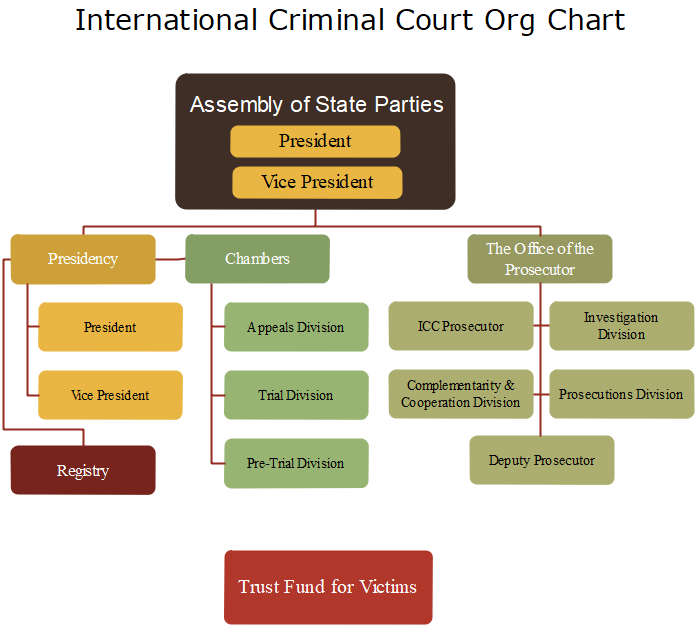The International Criminal Court (ICC) is not part of the United Nations System, but the court may cooperate with the UN for legal issues. The court was established by the Rome Statute. Currently, ICC is the world’s only permanent court for investigating international crimes of different issues, such as crimes against humanity and more. You can see an overview of the ICC org chart as below:

Main Organs of the International Criminal Court
ICC is mainly based in The Hague and the Netherlands with four dominant divisions: The Presidency, the Judicial Divisions, the Office of the Prosecutor, and the Registry.
Presidency
The Presidency of the International Criminal Court deals with administrative work like some legal and indicial affairs, and also external relations regarding public awareness. Normally, the Presidency assigns legal cases to Chambers, reviews and concludes final agreements with States.
Chambers
The Chambers has in total 18 judges in the Pre-Trial Division, the Trial Division, and the Appeals Division. Each of the division undertakes specific situations at different steps in terms of a general judicial procedure. Usually, the Pre-Trial Chamber decides whether to process the charges against any potential situations. The Trial Chamber determines whether to impose a sentence on a convicted individual. And finally, the Appeals Chamber may reverse the decision.
The Office Of The Prosecutor (OTP)
OTP of the International Criminal Court is generally responsible for collecting and analyzing any details on crimes and conducting related investigations before the Court. Only in case of adequate evidence then a case will be processed to the next stage of the Court. An investigation would not be carried out if the case does not meet the jurisdictional requirements.
Registry
The Registry assists all divisions of the International Criminal Court in terms of judicial and administrative issues. What’s more, the Registry undertakes programmes in the fields of defense, victims and witnesses, outreach and detention. More specifically, the Registry manages legal aid projects for defendants.
Trust Fund for Victims (TFV)
The TFV has two mandates to implement reparations include serving victims of crimes by offering both physical and psychological assistance. Such assistance is significant to victims and their families to recover from the harm.
How to Draw an International Criminal Court Org Chart?
The overall process is actually easier than you thought. Just check out this org chart creator guide for more useful skills and resources. Alternatively, feel free to use this easy org chart creator for more advanced settings and management of your business teams.
